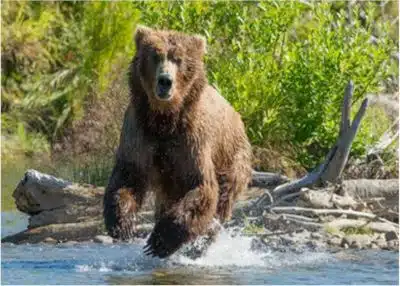
So you may like to know just how fast a bear is capable of running.
To the surprise of most, bears can achieve speeds up to thirty-five miles per hour, which is just as quick as the speed of a tiger.
This said, not all bears can reach the same speed, and how fast one can run varies based on their size and weight. There is no doubting their speed; they are fast and nimble animals and can move quickly when needed.
Despite their flat feet and big physique, bears are agile animals with strong forelegs that can propel them to fast speeds in no time. If you are curious, grizzly bears are the fastest of all species and can top thirty-five miles per hour, according to the National Wildlife Federation.
Grizzly bears are only a tad faster than American black bears, the most common bear species.
Of course, bears can only reach peak speed once time out of hibernation has passed, as they need time to restore the fifteen to thirty percent of fat and weight they lost during the process.
Even fresh out of hibernation, bears can move very quickly. Let’s take a look at the different bear species and the traits and characteristics that make their agility, fast speeds, and endurance possible. As you will soon learn, bears are very versatile animals.

How fast are bears able to run?
How fast can a bear run, and what speed can bears reach?
To begin, let us start with species of the Ursidae family that roam North America. The term Ursidae refers to mammals ranging from the giant panda to brown bears and polar bears. It also refers to extant and extinct bears, such as those that roamed across Eurasia and North America around forty million years ago.
Grizzly and Kodiak bears are the only brown-bear species in the United States. Below we cover their traits and speed and the characteristics that let them reach the high speeds they can achieve.
How fast can Kodiak Bears run?
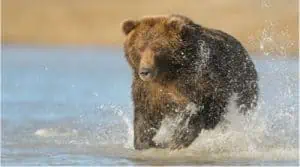
As the name implies, Kodiaks are indigenous to the Kodiak Archipelago region of Alaska. They can sustain a speed of twenty-five miles per hour for two miles but can run forty miles per hour for a short distance if they feel threatened or endangered. This is as fast as a zebra!
This is what is worrying, not only are they super fast over short distances but they are very fast over long distances. Certainly a bear that you want to observe from a safe distance or from a vehicle.
How fast can Grizzly Bears run?
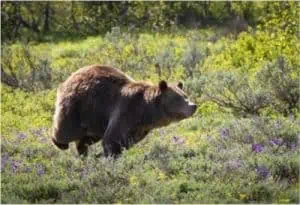
Also known as the North American Brown Bear, grizzly bears live in many parts of the USA and Canada and can reach thirty-five miles per hour over a short distance.
Similar to Kodiak bears (their closest relative), they can also reach forty miles per hour, but only when they feel their cubs or habitat is in danger.
Grizzlies and Kodiaks are the fastest bear species, but other members of the family are not far behind, below we cover the speeds of other bears along with a list of the regions in which they live.
How fast can Black Bears run?
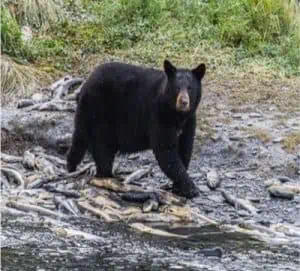
Black bears are a bit slower than Grizzlies as they can reach thirty miles per hour and only for up to half a mile. However, this is more than enough speed for them to catch prey and overtake their next meal.
As with any bear, speed varies based on age, dexterity, and environmental conditions. A bear with a winter coat and plenty of fat reserves will be slower than a lean, fresh bear out of hibernation.
That said, thirty miles per hour is still fast, and while they may not outrun Grizzlies, their climbing skills let them out-climb predators and attackers. They can scale a hundred-foot tree in thirty seconds!
So if your plan to get away is to climb a tree, find a new plan and quickly.
How fast can Polar Bears run?
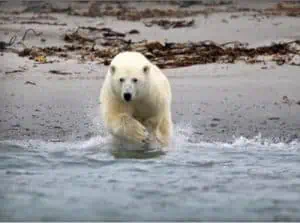
Polar bears are only found in Alaska, and there is a high chance you see them if you visit this Arctic state.
Like Kodiak bears (their relatives), Polar bears are enormous in size and weight and can weigh an astonishing fifteen hundred pounds.
The average weight of adult females is 330-550 pounds, and adult males average nine hundred and ninety pounds. For those curious, the largest polar bear recorded was shot and killed in Alaska in 1960. The bear was 2,209 pounds and stood nearly twelve feet in height.
If you assume, based on their weight, they are slower than bears in the Ursidae family, you are right. Their weight does inhibit their speed and ability to run as quickly as Black and Grizzly bears. However, do not let their weight mislead you, as they can run twenty-five miles per hour on both ice and land, making them extremely fast and agile.
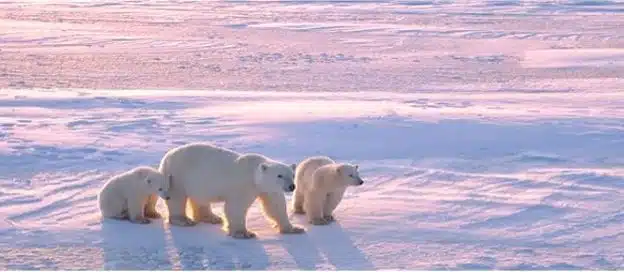
Speed and Weight of Bears – Regions They Reside and Thrive In
- Polar bears can reach twenty-five miles per hour but run fifteen miles per hour on average. They weigh 900-1,500 pounds and are found in the North Pole near the Arctic Circle.
- Black bears can reach thirty-five miles per hour but run thirty miles per hour on average. They weigh 90-551 pounds and are found in Alaska, Canada, Northern Mexico, and the United States.
- Kodiak bears can reach forty miles per hour but run twenty-five mph on average. They weigh 660-1,320 pounds and are found in a Southwest region of Alaska named the Kodiak Archipelago.
- Grizzly bears can reach forty miles per hour but run thirty-five mph on average. They weigh 700-1,700 pounds and live in Idaho, Alaska, Wyoming, Montana, Washington, Southern Colorado, and Western Canada.
How are bears able to run fast?
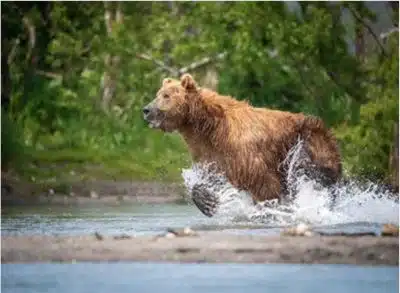
Polar, black, and grizzly bears run faster than any human. They can outpace even the fastest dogs that would stand no chance in an attack from one of these quick, strong, powerful mammals.
To start, bears are omnivorous, which means they thrive on animal and plant life.
Depending on the breed and species, their diets may be sixty to ninety percent plants. They have to work harder and smarter to get their paws on fresh meat, which they rely on to give them the massive amount of energy and protein they need.
While bears look like large, pudgy animals, they have big, dense, and strong muscles under their fur. They also have claws that offer traction on all surfaces. These let them thrust to over thirty miles per hour in seconds! The speed of bears can be purely attributed to the strength and muscle mass Mother Nature chose to bestow them.
Why are bears able to run fast?
How can bears run so fast with flat feet, huge stomachs, and thick, heavy layers of fur?
Well, beneath these deceiving layers are heaps of muscle mass. When bears rejuvenate and come out of hibernation in Spring, they are well revitalized and use their immense strength to achieve speeds of up to forty miles per hour.
One interesting fact about bears is that their strength and muscles are not negatively affected due to hibernation.
Unlike humans, who lose strength if muscles are not used for long periods of time, bear muscles are not impacted by inactivity. The fact they can run and roam a day out of hibernation shows just how strong their muscles really are.
Strength aside, another reason bears can reach high speeds is that they have long, sharp claws that can reach four inches in length. These claws let them have excellent traction on both dirt and soil and enable them to reach the speeds they do. However, their claws do hinder their speed on hard surfaces like wood and concrete.
It is a good thing bears run as fast as they do, as they need to be able to catch prey. Fish and berries are not the best sources of protein, so they need to catch animals like deer and moose to get the protein and nutrients they need to thrive. Doing so requires them to be fast, agile, and on top of their game.
Can people outrun bears?
Can a person outrun a bear?
Do bears run faster than people?
Not even Usain Bolt, the fastest human on Earth who reached twenty-eight miles per hour in 2009, can outpace a grizzly bear as he would still be seven miles per hour too slow if chased by one. Humans cannot outrun a bear running at full speed, so be sure to keep your distance from them if you see any.
Adding to the fact that the speed of bears is much greater than that of people, the high endurance levels of bears let them sustain high speeds for extended periods of time. They are able to sprint at over twenty-five miles per hour for two miles, while Usain Bolt could only maintain his top speed for a mere ten seconds.
On average, humans can run fifteen miles per hour, half as fast as a bear. The good news is that bears and other wildlife often prefer to avoid all contact with people. They tend only to chase or attack humans when they feel the need to protect cubs or food.
So how fast do bears run, and at what speed do bears travel? Here is a list of bear species and the top speed for each:
- Sun bear – 30 mph
- Sloth bear – 20 mph
- Polar bear – 25 mph
- Panda bear – 20 mph
- Brown bear – 35 mph
- Spectacled bear – 30 mph
- Asiatic black bear – 25 mph
- North American black bear – 30 mph
How are bears able to run so fast?
The burly shape and thick fur layers make the speed of bears surprising. Grizzly bears, for example, have large shoulder blades and protruding, high-strength muscles that let them dig and run at fast rates.
Grizzly bears have large and protruding back muscles that make it easy to tell them apart from others.
Bears also have large-strong claws that can grow over four inches long, slowing them down on asphalt and hard surfaces but helping them achieve peak speed on soft land in their natural habitat. Bears also have short forelimbs, which means their arms can carry or support more weight than their rear legs.
Their odd stature and lopsided physique have led many to think bears are unable to run down hills and slopes. This myth has long been debunked. A 1937 article from Yellowstone Nature Notes presented evidence of a bear named Clubfoot that was faster going downhill than uphill.
Ultimately, how fast a bear can run varies based on the bear and species, but all have powerful muscles and incredible endurance levels that permit them to reach the high speeds they do. If you ever encounter a bear, head away and keep a reasonable distance away, as outrunning them is impossible for people.
What should I do if I see a bear?
As one may guess, you should always avoid contact with bears in the wild. This may sound hard to do when hiking in the great outdoors, but there are things you can do to ensure you keep a safe distance from them.
To the surprise of many, bears prefer isolation and distance from people. Therefore, making noise on treks or hikes is a wise idea as it will alert any bears around to your presence and give them a chance to leave the area. If you are camping for the night or weekend, ensure all food and leftovers are tightly and securely stored in containers that mask the scent. Bears have a fantastic sense of smell and will easily perceive your food and snacks.
If you come across a bear and are in close proximity to it, be sure to remain as calm as possible. Do not make any sudden movements or loud, high-pitched noises, and the bear will probably leave you alone.
If you follow this advice, the bear will not view you as a threat. Never turn your back on a bear, but slowly walk away at a slant and continue until you see the bear moving away.
If you encounter a bear, you should:
- Walk backward at a slow pace and leave room and distance for you and the bear to leave.
- Slowly wave your arms as you speak calmly so the bear knows you are human and not prey.
- Appear as big as you can to deter the bear, move to high ground or stand on a tree stump as you wave your arms or shirt; the bigger you appear, the more likely the bear will be scared and leave.
If you plan on hiking in regions where bears thrive, it is best to bring bear spray in case you come in contact with one. A bear sprayed with it will be immobilized as it not only causes the nose, eyes, and lungs to swell up but inhibits their eyesight and breathing. These effects last about forty-five minutes, and no permanent harm is caused to the bear once they wear off.
How Fast Can a Bear Run? Summary and Conclusion on Bear Running Speeds
Bears are not soft and cuddly as our childhood teddy bear led us to believe. They are fast, agile, and strong wild animals. Polar and Kodiak bears, the slowest in the Ursidae family, can run twenty-five miles an hour, black bears can reach thirty miles per hour, and grizzlies, the fastest of them all, can run at forty miles per hour. Not even Usain Bolt, the fastest human on the planet, could outrun a grizzly chasing him.
Remember, if you ever encounter a bear in the wild, do not run away or make loud noises. Stay calm, speak softly, and retreat away at a slow and consistent pace until you can get to safety.
In conclusion, the world of bears is both fascinating and diverse, encompassing a range of species with unique characteristics. Each species possesses a special charm, from the majestic grizzly bear to the elusive polar bear. When it comes to speed, bears are surprisingly swift despite their large size. Remember, respect for their natural habitat and understanding of proper bear etiquette can help ensure peaceful coexistence between humans and these magnificent creatures.




